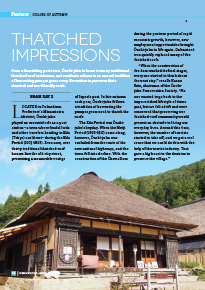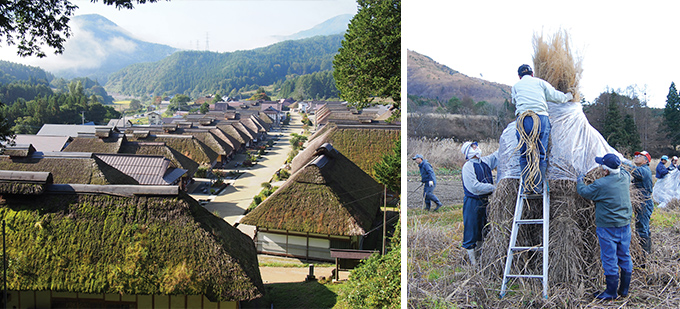Home > Highlighting JAPAN >Highlighting Japan November 2015>Colors of Autumn
Highlighting JAPAN

Colors of Autumn
Thatched Impressions
Once a flourishing post town, Ōuchi-juku is home to many traditional thatched-roof residences, and residents adhere to an annual tradition of harvesting pampas grass every November to preserve their classical and eco-friendly roofs.

Located in Fukushima Prefecture’s Minamiaizu district, Ōuchi-juku played an essential role as a post station—a town where feudal lords and other travelers heading to Edo (Tokyo) could rest—during the Edo Period (1603-1868). Even now, over thirty traditional thatched-roof houses line the old city street, presenting a memorable vestige of Japan’s past. In late autumn each year, Ōuchi-juku follows a tradition of harvesting the pampas grass used to thatch the roofs.
The Edo Period was Ōuchi-juku’s heyday. When the Meiji Period (1868-1912) came along, however, Ōuchi-juku was excluded from the route of the new national highways, and the town fell into decline. With the construction of the Ōkawa Dam during the postwar period of rapid economic growth, however, new employment opportunities brought Ōuchi-juku to life again. Galvanized iron quickly replaced many of the thatched roofs.
“When the construction of the dam reached its final stages, everyone started to think about the next step.” recalls Kazuo Sato, chairman of the Ōuchi-juku Preservation Society. “No one wanted to go back to the impoverished lifestyle of times past, but we felt adrift and were concerned that preserving our thatched-roof community would present an obstacle to living our everyday lives. Around this time, however, the number of tourists started to take off, and we got a real sense that we could do this with the help of the tourist industry. That gave a big boost to the decision to preserve the village.”
In 1981, Ōuchi-juku was designated a Group of Traditional Buildings, a preservation district established by Japan’s Agency of Cultural Affairs, and the conservation of the thatched roofs began in earnest.
The thatch-cutting takes place on a clear day in November after the bulk of the local farmwork is done. The timing is related to the fact that Ōuchi-juku is located in Japan’s northeast, a region known for its deep snow during the winter. Thus the timing for harvesting the pampas is key: it has to be done while the moisture content of the grass is not too high and, just as importantly, before the first snow of the season falls. In the past, the cut grass was stored under the thatch roof and consequently fumigated by smoke rising up from the hearth. This technique is no longer practiced today, however.
About forty people from the community harvest the pampas grass in nearby uncultivated fields and other pampas habitats. While the residents claim that no special technique is needed to cut the thatch—the grass is simply gathered and cut with sickles—the process unquestionably takes physical strength and stamina. The aging of the local population has led to a decrease in manpower, making it difficult for the community to harvest enough thatch. Therefore, residents say, they must also purchase grass from merchants in several different villages. The cut grass is usually stacked in fields and left to dry until the snow melts in spring, then stored in warehouses. Given current circumstances, however, the thatch ends up being used within the year.
The rethatching work consists basically of tying the dried grass together with straw, layering it in “old-new-old-new” order and anchoring it with bamboo, working back and forth from the bottom of the roof to the top. Particularly skilled workers are sought for the sections on the top and sides of the roof. To train young thatchers, a thatched practice roof has been constructed at a local school that closed, and every week up to ten workers learn thatching skills here from a master thatcher. Once they are trained, the thatchers leave to take on new thatching jobs, not only locally but all over the country.
“The grass is a sustainable crop where nothing goes to waste,” Sato explains. “The thatched houses are so cool in the summer that they don’t need air conditioning, and in winter the thatch is so thick that the insulating effect keeps them relatively warm. And having thatched houses all lined up in a row—isn’t that just a classic scene of Japan? Thatch-cutting is a communal shared effort and an important job in the late autumn. We want to continue preserving this custom and pass the culture of thatched roofs on to the next generation.”
© 2009 Cabinet Office, Government of Japan






